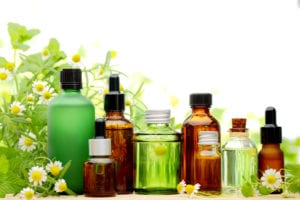Written by Greg Arnold, DC, CSCS. Nurses who gargled with a blend of peppermint, tea tree and lemon oils had a significant reduction in stress, xerostomia and halitosis compared to those who gargled with saline.
 There are currently more than 4.1 million professionally active nurses in the United States 1. Nursing is a high-stress job, and the stress effects on nurses has been catalogued since the 1950s 2.
There are currently more than 4.1 million professionally active nurses in the United States 1. Nursing is a high-stress job, and the stress effects on nurses has been catalogued since the 1950s 2.
Prolonged stress may cause physiological changes that impact the nervous, endocrine and immune system and ultimately affect oral health and lead to bad breath 3. Studies using essential oil aromatherapy have been shown to reduce stress. Since stress correlates highly with dry mouth and halitosis researchers, by providing a blend of peppermint, tea tree, and lemon as a gargle to nurses, hoped to validate the effects of essential oils on stress, dry mouth and salivary pH inhalation.
The following 2017 study 4 investigates the effects of essential oils on stress, xerostomia (dry mouth) halitosis and salivary pH. One hundred and twenty nurses between the ages of 23 and 30 were assigned to 1 of 3 groups:
Group 1: Aroma gargling (40 nurses). An aromatic solution was made with peppermint (Mentha piperita), lemon (Citrus limon), and tea tree (Melaleuca alternifolia), and ylang ylang (Cananga odorata) in 1:1:2:1 ratio. Each nurse was given 15-30 mL and gargled for 10-15 seconds once daily at 4 pm for 3 days.
Group 2: Saline gargling (40 nurses). Gargling 15-30 mL of saline solution for 10-15 seconds once daily at 4 pm for 3 days.
Group 3: No treatment (Control = 40 nurses).
Before and after the study, each nurse completed questionnaires to assess stress levels 5 and dry mouth severity 6.
After 3 days, those in the aroma gargling group experienced statistically significant improvements in stress and dry mouth severity when compared to the saline gargle group and control group. (p<0.001)
| Control | p - value | Saline gargle | p - value | Aroma gargle | p - value | |
|---|---|---|---|---|---|---|
| Salivary pH | 0.5% decrease (6.68 to 6.65) | < 0.001 | 2.6% increase (6.70 to 6.88) | < 0.001 | 8% increase (6.61 to 7.14) | < 0.001 |
| Stress | 3.9% increase (33.35 to 34.68) | < 0.001 | 8% decrease (34.80 to 32.03) | < 0.001 | 17.7% decrease (33.93 to 27.93) | < 0.001 |
| Dry mouth | 6.1% increase (2.45 to 2.60) | < 0.001 | 2.9% decrease (2.45 to 2.38) | < 0.001 | 51.4% decrease (2.53 to 1.23) | < 0.001 |
Aromatic mouthwash significantly alleviated stress, significantly improved xerostomia (dry mouth), and significantly increased PH compared to the saline mouthwash and no mouthwash. (p<0.001)
When suggesting mechanisms of action for the reduction in halitosis, the researchers pointed to the antimicrobial/antifungal 7 and stress-reducing properties 8 of the oils in the aroma gargle. Tea tree and peppermint oils also promote digestion and saliva secretion 7. Halitosis, caused by volatile sulfur compounds that are the end product of putrefaction by oral bacteria 7 , may also have been helped by the increased pH in the aroma group. People with halitosis have low saliva secretion which is more acidic and contributes to greater halitosis 9. When dry mouth decreased and salivary pH increased, halitosis was reduced.
For the researchers, “as gargling is an intervention that takes little time and is convenient to use, and may be helpful in enhancing the quality of life of nurses who do shift work.”
Source: See, Eun-Young, Ji-Ah Song, Myung-Haeng Hur, Mi-kyoung Lee, and Myeong Soo Lee. “Effects of aroma mouthwash on stress level, xerostomia, and halitosis in healthy nurses: A non-randomized controlled clinical trial.” European Journal of Integrative Medicine (2017).
© 2017 Elsevier GmbH. All rights reserved.
Posted November 21, 2017,
References:
- Foundation KF. Total Number of Professionally Active Nurses. 2017; Total number of professionally active nurses in U.S., by state. Available at: https://www.kff.org/other/state-indicator/total-registered-nurses/?currentTimeframe=0&sortModel=%7B%22colId%22:%22Location%22,%22sort%22:%22asc%22%7D. Accessed November 15, 2017, 2017.
- BM J. Work Stress and Burnout Among Nurses: Role of the Work Environment and Working Conditions. In: RG H, ed. Patient Safety and Quality: An Evidence-Based Handbook for Nurses. Rockville MD2008.
- Bergdahl M, Bergdahl J. Low unstimulated salivary flow and subjective oral dryness: association with medication, anxiety, depression, and stress. Journal of Dental Research. 2000;79(9):1652-1658.
- Seo E-Y, Song J-A, Hur M-H, Lee M-k, Lee MS. Effects of aroma mouthwash on stress level, xerostomia, and halitosis in healthy nurses: A non-randomized controlled clinical trial. European Journal of Integrative Medicine. 2017.
- Lesage F-X, Berjot S, Deschamps F. Clinical stress assessment using a visual analogue scale. Occupational medicine. 2012;62(8):600-605.
- Pai S, Ghezzi EM, Ship JA. Development of a Visual Analogue Scale questionnaire for subjective assessment of salivary dysfunction. Oral Surgery, Oral Medicine, Oral Pathology, Oral Radiology, and Endodontology. 2001;91(3):311-316.
- Battaglia S. The complete guide to aromatherapy. International Centre of Holistic Aromatherapy; 2003.
- Buckle J. Clinical Aromatherapy. Churchill Livingstone; 2003.
- Oh JK, Kim Y, Kho H. A study on the clinical characteristics of patients with dry mouth. Korean J Oral Med. 2001;26(26):331-343.

